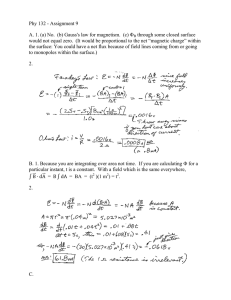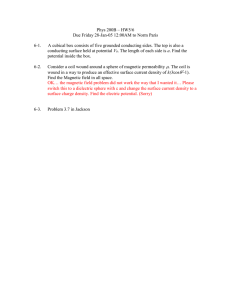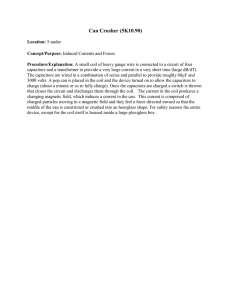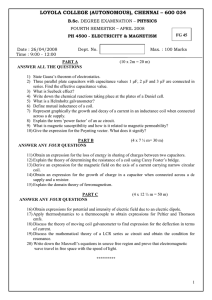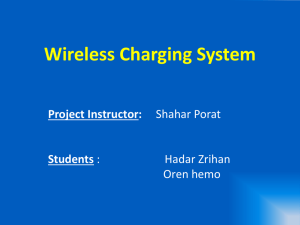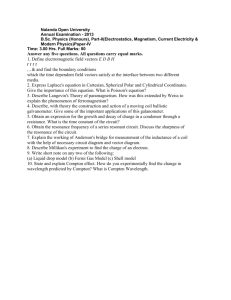Automatic Wireless Mobile Charger
advertisement
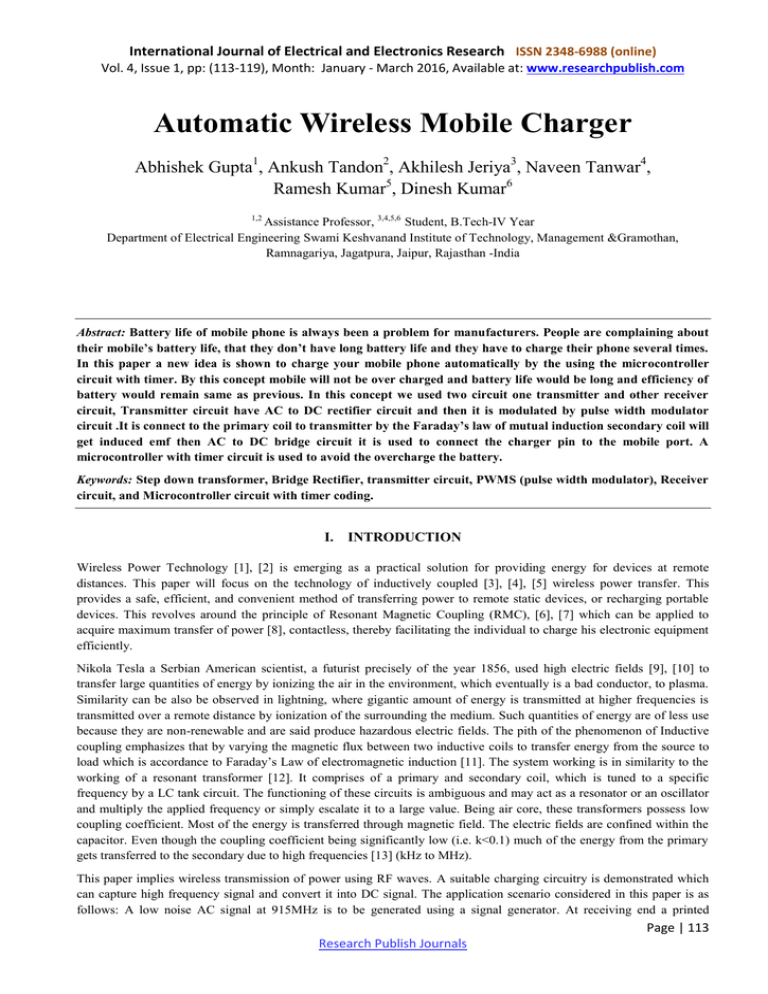
International Journal of Electrical and Electronics Research ISSN 2348-6988 (online) Vol. 4, Issue 1, pp: (113-119), Month: January - March 2016, Available at: www.researchpublish.com Automatic Wireless Mobile Charger Abhishek Gupta1, Ankush Tandon2, Akhilesh Jeriya3, Naveen Tanwar4, Ramesh Kumar5, Dinesh Kumar6 1,2 Assistance Professor, 3,4,5,6 Student, B.Tech-IV Year Department of Electrical Engineering Swami Keshvanand Institute of Technology, Management &Gramothan, Ramnagariya, Jagatpura, Jaipur, Rajasthan -India Abstract: Battery life of mobile phone is always been a problem for manufacturers. People are complaining about their mobile’s battery life, that they don’t have long battery life and they have to charge their phone several times. In this paper a new idea is shown to charge your mobile phone automatically by the using the microcontroller circuit with timer. By this concept mobile will not be over charged and battery life would be long and efficiency of battery would remain same as previous. In this concept we used two circuit one transmitter and other receiver circuit, Transmitter circuit have AC to DC rectifier circuit and then it is modulated by pulse width modulator circuit .It is connect to the primary coil to transmitter by the Faraday’s law of mutual induction secondary coil will get induced emf then AC to DC bridge circuit it is used to connect the charger pin to the mobile port. A microcontroller with timer circuit is used to avoid the overcharge the battery. Keywords: Step down transformer, Bridge Rectifier, transmitter circuit, PWMS (pulse width modulator), Receiver circuit, and Microcontroller circuit with timer coding. I. INTRODUCTION Wireless Power Technology [1], [2] is emerging as a practical solution for providing energy for devices at remote distances. This paper will focus on the technology of inductively coupled [3], [4], [5] wireless power transfer. This provides a safe, efficient, and convenient method of transferring power to remote static devices, or recharging portable devices. This revolves around the principle of Resonant Magnetic Coupling (RMC), [6], [7] which can be applied to acquire maximum transfer of power [8], contactless, thereby facilitating the individual to charge his electronic equipment efficiently. Nikola Tesla a Serbian American scientist, a futurist precisely of the year 1856, used high electric fields [9], [10] to transfer large quantities of energy by ionizing the air in the environment, which eventually is a bad conductor, to plasma. Similarity can be also be observed in lightning, where gigantic amount of energy is transmitted at higher frequencies is transmitted over a remote distance by ionization of the surrounding the medium. Such quantities of energy are of less use because they are non-renewable and are said produce hazardous electric fields. The pith of the phenomenon of Inductive coupling emphasizes that by varying the magnetic flux between two inductive coils to transfer energy from the source to load which is accordance to Faraday‟s Law of electromagnetic induction [11]. The system working is in similarity to the working of a resonant transformer [12]. It comprises of a primary and secondary coil, which is tuned to a specific frequency by a LC tank circuit. The functioning of these circuits is ambiguous and may act as a resonator or an oscillator and multiply the applied frequency or simply escalate it to a large value. Being air core, these transformers possess low coupling coefficient. Most of the energy is transferred through magnetic field. The electric fields are confined within the capacitor. Even though the coupling coefficient being significantly low (i.e. k<0.1) much of the energy from the primary gets transferred to the secondary due to high frequencies [13] (kHz to MHz). This paper implies wireless transmission of power using RF waves. A suitable charging circuitry is demonstrated which can capture high frequency signal and convert it into DC signal. The application scenario considered in this paper is as follows: A low noise AC signal at 915MHz is to be generated using a signal generator. At receiving end a printed Page | 113 Research Publish Journals International Journal of Electrical and Electronics Research ISSN 2348-6988 (online) Vol. 4, Issue 1, pp: (113-119), Month: January - March 2016, Available at: www.researchpublish.com monopole antenna tuned at same frequency that will capture signal transmitter. Output of receiving antenna is to be connected to charging circuitry which converts high frequency AC signal to DC, to get more of output voltage doubler circuit is to be connected which rectifies as well as doubles the voltage present at input, number of stages Used is directly proportional to number of times voltage doubles. Finally required output is to be taken at multi stage voltage doubler‟s end. II. LITERATURE REVIEW For better comprehension theories related to Magnetic Resonant Coupling, quality factor and optimization techniques for wireless power transfer systems are presented here along with the working principles and constructions of various components. Magnetic coupling is an old and well understood method in the field of wireless power transfer. But as the magnetic field decay very quickly, magnetic field is effective only at a very short distance. By applying resonance with in magnetic coupling the power transfer at a greater distance can be obtained. For near field wireless power transfer, Magnetic resonant coupling can bathe most effective method than any other method available. The block diagram for the whole experiment is shown below. It is consisting of an AC source, rectifier, oscillator, transmitter, secondary sources and load coil. It is observed that the voltage of 220V is connected to the transformer. The transformer is then connected to the transmitter circuit as a source of supply. Fig.1. Block Diagram A. INDUCTIVE OR MAGNETIC COUPLING: Inductive or Magnetic coupling works on the principle of electromagnetism. Transferring energy between wires through magnetic fields is inductive coupling. If a portion of the magnetic flux established by one circuit interlinks with the second circuit, then two circuits are coupled magnetically and the energy may be transferred from one circuit to the another circuit. This energy transfer is performed by the transfer of the magnetic field which is common to the both circuits. Fig.2. Magnetic coupling with four component fluxes Page | 114 Research Publish Journals International Journal of Electrical and Electronics Research ISSN 2348-6988 (online) Vol. 4, Issue 1, pp: (113-119), Month: January - March 2016, Available at: www.researchpublish.com B. MAGNETIC RESONANT COUPLING: Magnetic Resonant coupling uses the same principles as inductive coupling, but it uses resonance to increase the range at which the energy transfer can efficiently take place. Resonance can be two types: (a) series resonance & (b) parallel resonance. In these both types of resonance the principle which is to get maximum energy transfer is same but the methods are quite different. Fig.3. Equivalent Circuit of Magnetic Resonant Coupling C. RESONANT FREQUENCY: Resonance is a phenomenon that causes an object to vibrate when energy of a certain frequency is applied. In physics, resonance is the tendency of a system (usually a linear system) to oscillate with larger amplitude at some frequencies than at others. These are known as the system‟s resonant frequencies. In these particular frequencies, small periodic driving forces even can produce oscillations having large amplitude. D. QUALITY FACTOR: In physics and engineering the Quality factor (Q -factor) is a dimensionless parameter that describes the characteristics of an oscillator or resonator, or equivalently, characterizes a resonator‟s bandwidth relative to its central frequency. Higher Q indicates the stored energy of the oscillator is relative of a lower rate of energy loss and the oscillations die out more slowly. So it can be stated that, Oscillators with high quality factors have low damping so that they pendulum ring longer, in case of a pendulum example. In an ideal series RLC circuit and in a tuned radio frequency receiver (TRF) the Q factor can be written as: Q= √ Where, R, L and C are respectively the resistance, inductance and capacitance of the tuned circuit. III. CIRCUIT DESIGN AND IMPLEMENTATION Our experimental realization of the project consists of three coils that are tuned at the same frequency. An oscillating circuit is connected with a source coil S. Coil S is coupled resonant inductively to an intermediate coil Q which is coupled resonant inductively to a load carrying coil R. The coils are made up of an electrically conducting copper wire of crosssectional radius r. When a radio frequency oscillating signal is passed through the coil S, it generates an oscillating magnetic field, perpendicular to the coil S. The intermediate coil Q is placed near to the coil S, which is tuned at the same frequency through the inductance of the coil and a resonating capacitor C1. The coil Q being in the area of the magnetic field generated by coil S, receives power. Not having any resistive load, the coil in turn generates its own oscillating magnetic field. The advantage of using this coil is that it is completely separated from the source internal resistance. This increases the Q-factor, allowing greater power to be radiated. In other words, the coil Q becomes the source of the system. The load coil R, tuned at the same resonant frequency, receives the power through the magnetic field generated by the intermediate coil Q. The equivalent circuit diagram of power transfer model is given in figure-5. The power transfer occurs from coil S to coil R. The power loss in coil Q is neglected here, since the coil Q has a very small resistance. Page | 115 Research Publish Journals International Journal of Electrical and Electronics Research ISSN 2348-6988 (online) Vol. 4, Issue 1, pp: (113-119), Month: January - March 2016, Available at: www.researchpublish.com Fig.4. Theoretical Model of the System CIRCUIT DIAGRAM: Fig.5. The Equivalent circuit diagram for Theoretical Model of the System (A) TRANSMITTER CIRCUIT: Fig.6. Transmitter Circuit (B) RECEIVER CIRCUIT: Fig.7. Receiver Circuit Page | 116 Research Publish Journals International Journal of Electrical and Electronics Research ISSN 2348-6988 (online) Vol. 4, Issue 1, pp: (113-119), Month: January - March 2016, Available at: www.researchpublish.com HARDWARE IMPLEMENTATION:- Fig.8. Mechanical Implementation of the project COMPONENTS DISCRIPTION: TABLE: I COMPONENTS TABLE Name of Component MOSFETS Resistors Ultrafast Diodes Scotty diodes Battery LED IC Zener diodes LCD Resistors Resistors RFID Coil Tank capacitors Transformer Microcontroller Specification The IRFP250 10k ohm (brown black orange), 1/4 watt Above 400 volts. UF4007 4007 family 9 Volt 7805 Family 12 volt 16×2 18k ohm 1/4 watt (brown - gray - orange) 12k ohm 1/4 watt (brown - red – orange 1uf 0-12Volt ATMEGA 32A IV. RESULT AND SIMULATION Measurements are taken providing 220V supply along with the transformer, with resonant frequency 1.5 MHz across the transmitter and without the intermediate coil: An LED bulb lit up at its full strength at a distance of 7 centimetres with voltage measured 12 volt. An LED bulb lit up to a maximum distance of 17 centimetres with voltage measured 12 volts. Voltage measured at a distance 1 meter was 3 mill volts. Measurements taken with intermediate coil placed in between transmitter and receiver at a distance 12cm apart from the transmitter: Page | 117 Research Publish Journals International Journal of Electrical and Electronics Research ISSN 2348-6988 (online) Vol. 4, Issue 1, pp: (113-119), Month: January - March 2016, Available at: www.researchpublish.com For this experimental setup, the voltage across the transmitter is 12V. The output rms voltage across a resistive load 17cm away from the transmitting coil is 10.6V.The coils were arranged in the configuration as shown below and voltage measurements were taken as a function of distance between the coils. V. APPLICATIONS 1. Uses in stationary High Altitude Relay Platform (SHARP) [14] 2. Charging of electric vehicles [15] 3. Electronic portable devices [15] VI. ADVANTAGE 1. Safe for human, simple implementation 2. Charging multiple devices simultaneously on different power, high charging efficiency 3. It improves user-friendliness as the hassle from connecting cables is removed. Different brands and different models of devices can also use the same charger. 4. It enhances flexibility, especially for the devices for which replacing their batteries or connecting cables for charging is costly, hazardous, or infeasible (e.g. body-implanted sensors). 5. It renders the design and fabrication of much smaller devices without the attachment of batteries. 6. It provides better product durability (e.g., waterproof and dustproof) for contact-free devices. VII. CONCLUSION The goal of this paper was to design and implement a wireless power transfer system via magnetic resonant coupling. After analysing the whole system step by step for optimization, a system was designed and implemented. Experimental results showed that significant improvements in terms of power-transfer efficiency have been achieved. Measured results are in good agreement with the theoretical models. It is described and demonstrated that magnetic resonant coupling can be used to deliver power wirelessly from a source coil to a load coil with an intermediate coil placed between the source and load coil and with capacitors at the coil terminals providing a simple means to match resonant frequencies for the coils. This mechanism is a potentially robust means for delivering wireless power to a receiver from a source coil. The concept of charging a cellular phone battery using wireless RF energy harvesting can be feasible. While voltage across output is desirable but output current is quiet lower showing that battery or mobile phone will require much time to charge. Wireless low power transmission system would completely eliminate carrying chargers for mobile phones or tabloids. VIII. FUTURE SCOPE 1. Wireless Charger Network: - Similar to wireless communication networks that provide data service, a wireless charger network can be built to deliver energy provisioning service to distributed users. The wireless charger network that connects a collection of distributed chargers through wired or wireless links allows to exchange information (e.g., include availability, location, charging status, and cost of different chargers) to schedule the chargers. 2. Green Wireless Energy Provisioning: -Currently, how to perform green wireless energy provisioning remains an open issue and has been ignored by the majority of existing studies. One promising solution is to equip renewable energy sources, e.g., solar, for wireless chargers. 3. Open Issues in Wireless Charging: - The increase of wireless charging power density gives rise to several technical issues, e.g., thermal, electromagnetic compatibility, and electromagnetic field problems [16]. This requires high-efficiency power conversion techniques to reduce the power loss at an energy receiver and battery modules with effective ventilation design. Page | 118 Research Publish Journals International Journal of Electrical and Electronics Research ISSN 2348-6988 (online) Vol. 4, Issue 1, pp: (113-119), Month: January - March 2016, Available at: www.researchpublish.com REFERENCES [1] A. Costanzo, M. Dionigi, D. Masotti, M. Mongiardo, G. Monti, L. Tarricone, and R. Sorrentino, “Electromagnetic Energy Harvesting and Wireless Power Transmission: A Unified Approach,” Proceedings of the IEEE, vol. 102, no. 11, pp. 1692-1711, Nov. 2014. [2] J. Garnica, R. A. Chinga and J. Lin, “Wireless Power Transmission: From Far Field to Near Field,” Proceedings of the IEEE, vol. 101, no. 6, pp. 1321-1331, June 2013. [3] N. Tesla, “Apparatus for Transmitting Electrical Energy,” US patent number 1,119,732, issued in Dec. 1914. [4] R. Bhutkar, and S.Sapre, “Wireless Energy Transfer Using Magnetic Resonance,” in Proc. of International Conference on Computer and Electrical Engineering, Dubai, United Arab Emirates, Dec. 2009. [5] http://www.teslauniverse.com/nikola-tesla-article inventor-of-dreams [6] A. Kurset al. “Wireless power transfer via strongly coupled magnetic resonances,” SCIENCE, vol. 317, pp. 83-86, July 2007. [7] http://www.wirelesspowerconsortium.com/ [8] Z. N. Low, R. Chinga, R. Tseng, and J. Lin, “Design and Test of a Highpower High-efficiency Loosely Coupled Planar Wireless Power Transfer System,” IEEE Trans. Ind. Electron., vol. 56, no. 5, pp. 1801-1812, May 2009. [9] C. R. Valenta, and G. D. Durgin, “Harvesting Wireless Power: Survey of Energy-Harvester Conversion Efficiency in Far-Field, Wireless Power Transfer Systems,” IEEE Microwave Magazine, vol. 15, no. 4, pp. 108-120, June 2014. [10] J. C. Maxwell, „A Treatise on Electricity and Magnetism, 1873. [11] http://www.witricity.com. [12] Z. N. Low, R. Chinga, R. Tseng, and J. Lin, “Design and Test of a Highpower High-efficiency Loosely Coupled Planar Wireless Power Transfer System,” IEEE Trans. Ind. Electron., vol. 56, no. 5, pp. 1801-1812, May 2009. [13] C. S. Branch, “Limits of Human Exposure to Radio frequency Electromagnetic Energy in the Frequency Range from 3 kHz to 300 GHz,” safe code 6, 2009. [14] Wireless Power Transmission: An Innovative Idea, International Journal of Educational Planning & Administration. ISSN 22493093 Volume 1, Number 3 (2011). http://www.ripublication.com/ijepa/ijepav1n3_2.pdf [15] http://www.cse.wustl.edu/~jain/cse57414/ftp/power/index.html [16] S. Y. Hui, “Planar Wireless Charging Technology for Portable Electronic Products and Qi”Proceedings of the IEEE, vol. 101, no. 6, pp.1290-1301, June 2013. Page | 119 Research Publish Journals
